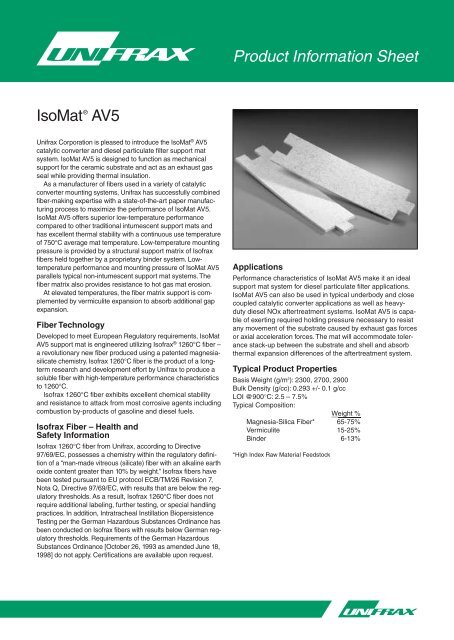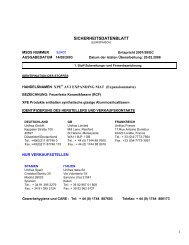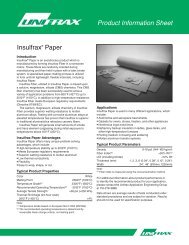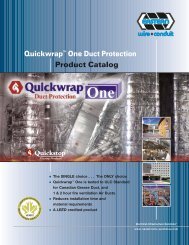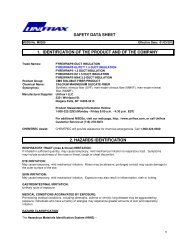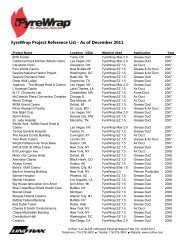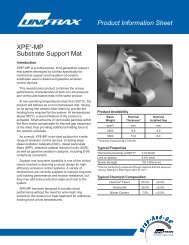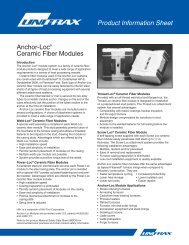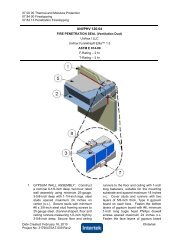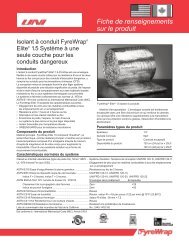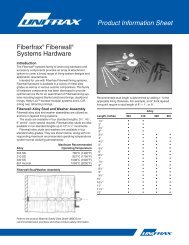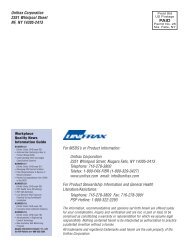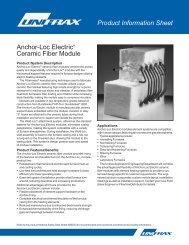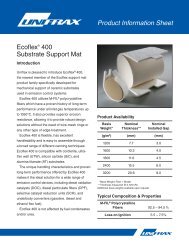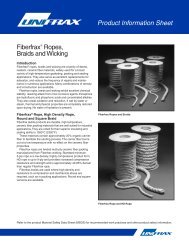IsoMat® AV5 (European version) (PDF) - Unifrax
IsoMat® AV5 (European version) (PDF) - Unifrax
IsoMat® AV5 (European version) (PDF) - Unifrax
You also want an ePaper? Increase the reach of your titles
YUMPU automatically turns print PDFs into web optimized ePapers that Google loves.
Product Information Sheet<br />
IsoMat ® <strong>AV5</strong><br />
<strong>Unifrax</strong> Corporation is pleased to introduce the IsoMat ® <strong>AV5</strong><br />
catalytic converter and diesel particulate filter support mat<br />
system. IsoMat <strong>AV5</strong> is designed to function as mechanical<br />
support for the ceramic substrate and act as an exhaust gas<br />
seal while providing thermal insulation.<br />
As a manufacturer of fibers used in a variety of catalytic<br />
converter mounting systems, <strong>Unifrax</strong> has successfully combined<br />
fiber-making expertise with a state-of-the-art paper manufacturing<br />
process to maximize the performance of IsoMat <strong>AV5</strong>.<br />
IsoMat <strong>AV5</strong> offers superior low-temperature performance<br />
compared to other traditional intumescent support mats and<br />
has excellent thermal stability with a continuous use temperature<br />
of 750°C average mat temperature. Low-temperature mounting<br />
pressure is provided by a structural support matrix of Isofrax<br />
fibers held together by a proprietary binder system. Lowtemperature<br />
performance and mounting pressure of IsoMat <strong>AV5</strong><br />
parallels typical non-intumescent support mat systems. The<br />
fiber matrix also provides resistance to hot gas mat erosion.<br />
At elevated temperatures, the fiber matrix support is complemented<br />
by vermiculite expansion to absorb additional gap<br />
expansion.<br />
Fiber Technology<br />
Developed to meet <strong>European</strong> Regulatory requirements, IsoMat<br />
<strong>AV5</strong> support mat is engineered utilizing Isofrax ® 1260°C fiber –<br />
a revolutionary new fiber produced using a patented magnesiasilicate<br />
chemistry. Isofrax 1260°C fiber is the product of a longterm<br />
research and development effort by <strong>Unifrax</strong> to produce a<br />
soluble fiber with high-temperature performance characteristics<br />
to 1260°C.<br />
Isofrax 1260°C fiber exhibits excellent chemical stability<br />
and resistance to attack from most corrosive agents including<br />
combustion by-products of gasoline and diesel fuels.<br />
Isofrax Fiber – Health and<br />
Safety Information<br />
Isofrax 1260°C fiber from <strong>Unifrax</strong>, according to Directive<br />
97/69/EC, possesses a chemistry within the regulatory definition<br />
of a “man-made vitreous (silicate) fiber with an alkaline earth<br />
oxide content greater than 10% by weight.” Isofrax fibers have<br />
been tested pursuant to EU protocol ECB/TM/26 Revision 7,<br />
Nota Q, Directive 97/69/EC, with results that are below the regulatory<br />
thresholds. As a result, Isofrax 1260°C fiber does not<br />
require additional labeling, further testing, or special handling<br />
practices. In addition, Intratracheal Instillation Biopersistence<br />
Testing per the German Hazardous Substances Ordinance has<br />
been conducted on Isofrax fibers with results below German regulatory<br />
thresholds. Requirements of the German Hazardous<br />
Substances Ordinance [October 26, 1993 as amended June 18,<br />
1998] do not apply. Certifications are available upon request.<br />
Applications<br />
Performance characteristics of IsoMat <strong>AV5</strong> make it an ideal<br />
support mat system for diesel particulate filter applications.<br />
IsoMat <strong>AV5</strong> can also be used in typical underbody and close<br />
coupled catalytic converter applications as well as heavyduty<br />
diesel NOx aftertreatment systems. IsoMat <strong>AV5</strong> is capable<br />
of exerting required holding pressure necessary to resist<br />
any movement of the substrate caused by exhaust gas forces<br />
or axial acceleration forces. The mat will accommodate tolerance<br />
stack-up between the substrate and shell and absorb<br />
thermal expansion differences of the aftertreatment system.<br />
Typical Product Properties<br />
Basis Weight (g/m 2 ): 2300, 2700, 2900<br />
Bulk Density (g/cc): 0.293 +/- 0.1 g/cc<br />
LOI @900°C: 2.5 – 7.5%<br />
Typical Composition:<br />
Weight %<br />
Magnesia-Silica Fiber* 65-75%<br />
Vermiculite 15-25%<br />
Binder 6-13%<br />
*High Index Raw Material Feedstock
Canning Performance<br />
As a function of the application, IsoMat <strong>AV5</strong> support mat<br />
is typically installed at a nominal gap bulk density (GBD)<br />
between 0.64 and 0.69. The compressive force of IsoMat <strong>AV5</strong><br />
support mat is shown in Figure 1. Ppeak is the maximum<br />
pressure measured during canning of the converter. Pres300<br />
is the residual pressure measured five minutes after canning.<br />
Typical Cold Compression<br />
IsoMat ® <strong>AV5</strong><br />
material. The lower the measured volume loss, the better the<br />
resistance to erosion. <strong>Unifrax</strong> IsoMat <strong>AV5</strong> has similar erosion<br />
resistance when compared to other commercially available<br />
traditional intumescent support mats when evaluated at their<br />
respective minimum GBD conditions.<br />
0.50<br />
0.40<br />
Average Erosion Durability<br />
Pressure (kPa)<br />
2500<br />
2000<br />
1500<br />
1000<br />
Ppeak<br />
Pres300<br />
Volume Loss-cm 3<br />
0.30<br />
0.20<br />
0.10<br />
500<br />
0<br />
0.40 0.45 0.50 0.55 0.60 0.65 0.70 0.75 0.80 0.85 0.90<br />
Performance<br />
GBD (g/cm 3 )<br />
Figure 1: Typical cold compression curves for IsoMat <strong>AV5</strong> support mat.<br />
At relatively low inlet temperatures, when average mat<br />
temperature between the substrate and shell is limited to<br />
about 300°C, laboratory testing indicates IsoMat <strong>AV5</strong> can<br />
provide 5 times more holding pressure than current Advanced<br />
Intumescent systems.<br />
When compared to a non-intumescent support mat system,<br />
at elevated inlet temperatures when the average mat temperature<br />
approaches 750°C, low-level concentrations of vermiculite<br />
present in the fiber matrix will expand, serving to increase<br />
holding force as the gap between the substrate and shell<br />
increases, thereby adding support.<br />
Erosion Durability<br />
The durability of a catalytic converter support material is of<br />
major importance to long-term converter efficiency and integrity.<br />
Mat erosion is most often the result of low mat pressure<br />
caused by the inability of a design to maintain targeted GBD.<br />
A design is unable to maintain GBD either due to shell spring<br />
deformation or when the temperature of the converter causes<br />
shell expansion to be too great for the mat to absorb. Pulsating<br />
exhaust gases then attack and erode the unsupported mat,<br />
resulting in bypass and a decrease in converter efficiency. The<br />
data provided in Figure 2 was generated in a laboratory test<br />
apparatus, which simulates a 4-cylinder engine running at<br />
6000 rpm. Support mat is installed in the apparatus at GBD<br />
conditions that are below recommended design limits. Erosion<br />
loss is calculated by measuring the volume loss of support mat<br />
0.00<br />
Traditional Intumescent<br />
IsoMat-<strong>AV5</strong><br />
Figure 2: Average Erosion Durability measured as volume loss.<br />
<strong>Unifrax</strong> is a worldwide sales and service organization with<br />
several international locations and representatives. The<br />
services that we provide include thermal modeling, system<br />
design engineering assistance, and failure analysis as well<br />
as technical exchanges programs. For additional information<br />
regarding IsoMat <strong>AV5</strong> or any of our catalytic support mats,<br />
please contact the <strong>Unifrax</strong> Automotive Application Engineering<br />
Department at 716-278-3983. In Germany, contact <strong>Unifrax</strong> at<br />
49 (0)211 87 746 0.<br />
Refer to the product Material Safety Data Sheet (MSDS) for<br />
recommended work practices and other safety information.<br />
Data are average results of tests conducted under standard<br />
procedures and are subject to variation. Results should not<br />
be used for specification purposes.<br />
Form C-3141-EU<br />
Effective 8/05<br />
© 2005 <strong>Unifrax</strong> Corporation<br />
All Rights Reserved<br />
Printed in USA<br />
Page 2 of 2<br />
The following are registered trademarks of <strong>Unifrax</strong> Corporation: IsoMat and Isofrax<br />
The test data shown are average results of tests conducted under standard procedures and<br />
are subject to variation. Results should not be used for specification purposes.<br />
Product Information Sheets are periodically updated by <strong>Unifrax</strong>. Before relying on any data<br />
or other information in this Product Information Sheet, you should confirm that it is still current<br />
and has not been superseded. A Product Information Sheet that has been superseded<br />
may contain incorrect, obsolete and/or irrelevant data and other information.<br />
<strong>Unifrax</strong> Corporation<br />
Corporate Headquarters<br />
2351 Whirlpool Street<br />
Niagara Falls, New York 14305-2413<br />
Telephone: 716-278-3800<br />
Telefax: 716-278-3900<br />
Internet: www.unifrax.com<br />
Email: info@unifrax.com<br />
<strong>Unifrax</strong> GmbH<br />
Kappeler Strasse 105<br />
D-40597 Düsseldorf<br />
Germany<br />
Telephone: 49 (0)211 87 746 0<br />
Telefax: 49 (0)211 87 746 115


